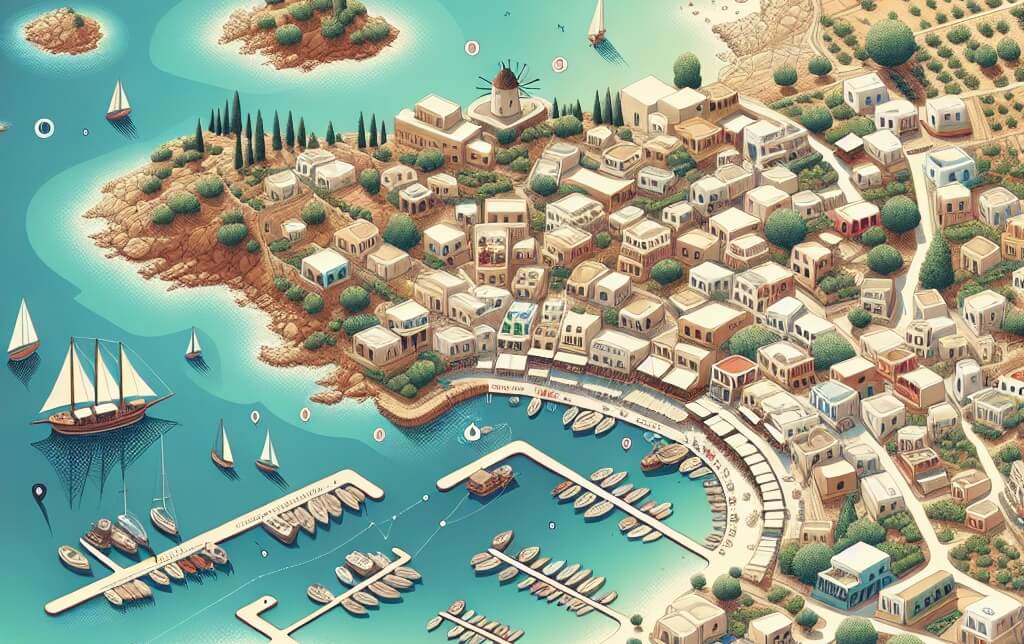
Explore Vravrona Greece: Travel Guide and Must-See Sights
Vravrona, located in eastern Attica, Greece, is a destination rich in history and natural beauty, making it a must-visit for travelers seeking an authentic Greek experience. The region is renowned for its archaeological sites, most notably the Temple of Artemis, a sacred sanctuary dedicated to the goddess of hunting and wilderness. Visitors can explore the ruins of this ancient temple and gain insight into the religious practices of the ancient Greeks. Additionally, Vravrona is home to a picturesque coastline with sandy beaches and crystal-clear waters, ideal for relaxation and water activities. Other notable sights include the Vravrona Wetland, a protected area that serves as a habitat for various bird species, offering a unique opportunity for birdwatching enthusiasts. Overall, Vravrona provides a blend of cultural heritage and natural wonders, making it a compelling destination for travelers interested in immersing themselves in the beauty of Greece.
Introduction
Vravrona, located in Greece, is a historically significant region renowned for its archaeological sites and cultural heritage. The introduction of Vravrona provides a glimpse into the rich history and ancient civilization that once thrived in this area. From the sanctuary of Artemis to the Temple of Artemis Brauronia, Vravrona stands as a testament to the religious and cultural practices of the ancient Greeks. Exploring the ruins and artifacts of Vravrona offers a unique opportunity to delve into the past and gain insights into the daily life and beliefs of the people who once inhabited this region.
Provide a brief overview of Vravrona Greece and its significance.
Vravrona, located in southeastern Attica, Greece, holds significant historical and archaeological importance. The area is renowned for its sanctuary dedicated to the goddess Artemis, known as the Sanctuary of Artemis at Brauron. This sanctuary was a place of worship and rituals, particularly for young girls transitioning into womanhood. The site also served as a center for the cult of Artemis Brauronia, where various festivals and ceremonies were held in her honor. The archaeological remains found in Vravrona provide valuable insights into the religious practices and beliefs of ancient Greece, making it a crucial site for understanding the cultural and spiritual life of the region during classical antiquity.
Historical Background
The historical background of Vravrona, Greece, is rich and significant. Located in the southeastern part of Attica, Vravrona holds archaeological remains dating back to ancient times, particularly the Sanctuary of Artemis, a key religious site dedicated to the goddess of hunting and wilderness. This sanctuary played a crucial role in the religious and cultural life of ancient Greeks, attracting pilgrims and worshippers from various regions. The area's history is also marked by its strategic importance, being situated near the sea and serving as a point of connection between Athens and other city-states. Furthermore, Vravrona's past is intertwined with myths and legends, adding to its allure as a site of historical and cultural interest in Greece.
Discuss the ancient history of Vravrona Greece and its role in ancient Greek civilization.
Vravrona, located in southeastern Attica, Greece, holds significant historical importance in ancient Greek civilization. The area was primarily known for its sanctuary dedicated to the goddess Artemis, one of the most revered deities in Greek mythology. The sanctuary served as a religious center and a place of pilgrimage for worshippers seeking divine favor and protection. Additionally, Vravrona was a key site for the worship of Iphigenia, the daughter of Agamemnon, who was believed to have been sacrificed to Artemis in exchange for favorable winds during the Trojan War. The sanctuary at Vravrona played a crucial role in the religious and cultural life of ancient Greeks, reflecting their beliefs, rituals, and societal values. The archaeological remains found in Vravrona provide valuable insights into the religious practices and daily life of the ancient Greeks, highlighting the enduring significance of this site in the study of ancient Greek civilization.
Archaeological Site
The archaeological site of Vravrona in Greece is a significant historical location that offers valuable insights into the ancient civilization of the region. This site, located in Attica near the town of Markopoulo, is home to the Temple of Artemis, a sacred sanctuary dedicated to the goddess of hunting and wilderness. Excavations at Vravrona have unearthed numerous artifacts and structures dating back to the Archaic and Classical periods, shedding light on the religious practices, social customs, and artistic achievements of the ancient Greeks. The meticulous preservation and ongoing research at this archaeological site contribute to our understanding of the cultural heritage of Greece and its enduring influence on Western civilization.
Explore the archaeological site of Vravrona and its importance in understanding the ancient Greek culture.
The archaeological site of Vravrona in Greece holds significant importance in unraveling the mysteries of ancient Greek culture. Located near the eastern coast of Attica, Vravrona was a sacred sanctuary dedicated to the goddess Artemis, the protector of wild animals and the goddess of hunting. The site features the remains of a temple dedicated to Artemis, as well as various other structures and artifacts that provide valuable insights into the religious practices, social structure, and daily life of the ancient Greeks. Excavations at Vravrona have unearthed a wealth of pottery, figurines, and inscriptions, shedding light on the rituals and beliefs of the worshipers who frequented the sanctuary. By studying the archaeological finds at Vravrona, scholars can gain a deeper understanding of the spiritual, artistic, and societal aspects of ancient Greek civilization.
Shrine of Artemis
The Shrine of Artemis, located in Vravrona, Greece, is a significant archaeological site dedicated to the worship of the goddess Artemis. This ancient sanctuary, dating back to the 6th century BC, served as a place of pilgrimage and religious ceremonies for the followers of Artemis. The site is renowned for its well-preserved ruins, including a temple, stoa, and various votive offerings. The Shrine of Artemis not only showcases the architectural and artistic achievements of the ancient Greeks but also provides valuable insights into their religious practices and beliefs. Today, the site stands as a testament to the enduring legacy of Artemis and the cultural heritage of Greece.
Examine the significance of the Shrine of Artemis in Vravrona and its role in ancient religious practices.
The Shrine of Artemis in Vravrona, Greece, holds significant importance in the realm of ancient religious practices. Dedicated to the goddess Artemis, the sanctuary served as a focal point for religious worship and rituals. As one of the key cult sites of Artemis in Attica, the shrine attracted pilgrims from far and wide seeking divine favor, protection, and blessings. The sanctuary also played a crucial role in the celebration of various religious festivals and ceremonies dedicated to Artemis, further solidifying its status as a sacred site of reverence and devotion. The architecture and layout of the shrine, including the temple, altars, and other religious structures, reflected the beliefs and practices of the ancient Greeks, emphasizing the connection between the mortal realm and the divine. Overall, the Shrine of Artemis in Vravrona stood as a testament to the enduring power and significance of religious devotion in the ancient world.
Temple of Artemis Brauronia
The Temple of Artemis Brauronia, located in Vravrona, Greece, holds significant historical and religious importance. This ancient sanctuary was dedicated to the goddess Artemis, known as the protector of women and the goddess of the hunt. The temple was a place of worship and pilgrimage for devotees seeking blessings, protection, and fertility. The architectural design of the temple, with its Doric columns and intricate sculptures, reflects the grandeur and reverence with which Artemis was revered in ancient Greek society. The Temple of Artemis Brauronia stands as a testament to the enduring legacy of Greek mythology and religious practices, attracting visitors and scholars alike to marvel at its cultural and historical significance.
Discuss the Temple of Artemis Brauronia in Vravrona and its architectural features.
The Temple of Artemis Brauronia in Vravrona, Greece, is a significant archaeological site that showcases remarkable architectural features. Constructed in the 6th century BCE, this temple was dedicated to the goddess Artemis, the protector of women and young girls. The temple's design followed the typical Doric style, characterized by its simple and sturdy columns with no base and a plain, unadorned frieze. The temple also featured a pronaos, a cella, and an opisthodomos, all essential elements of ancient Greek temple architecture. The exterior of the temple was adorned with intricate sculptures and decorative elements, reflecting the artistic and religious significance of the site. The Temple of Artemis Brauronia in Vravrona stands as a testament to the skill and craftsmanship of ancient Greek architects and artisans, serving as a reminder of the rich cultural heritage of the region.
Museum Vravrona
Museum Vravrona, located in Vravrona, Greece, is a significant cultural institution that showcases the rich history and heritage of the region. The museum is renowned for its impressive collection of artifacts, including ancient pottery, sculptures, and other archaeological finds that provide valuable insights into the daily life and practices of the ancient inhabitants of Vravrona. Visitors to Museum Vravrona have the opportunity to immerse themselves in the fascinating history of the area, gaining a deeper understanding of its cultural significance. The museum serves as a vital educational resource, preserving and promoting the cultural heritage of Vravrona for future generations to appreciate and learn from.
Explore the Museum Vravrona and its collection of artifacts related to the history and culture of Vravrona Greece.
The Museum of Vravrona offers a captivating journey through the rich history and culture of Vravrona, Greece. Its collection of artifacts provides a window into the ancient past of this significant region. Visitors can admire a diverse array of items, ranging from pottery and sculptures to tools and jewelry, all meticulously preserved and displayed. These artifacts offer valuable insight into the daily life, religious practices, and artistic achievements of the people who once inhabited Vravrona. Exploring the museum allows one to appreciate the depth of history and cultural heritage that Vravrona holds, making it a must-visit destination for those interested in the ancient world of Greece.
Clothe Woman and Woman Die
The phrase "Clothe Woman and Woman Die" evokes a sense of mystery and intrigue, particularly when considering the context of Vravrona, Greece. Vravrona is a historical site located in eastern Attica, known for its ancient temple dedicated to the goddess Artemis. In the context of this phrase, one could interpret it as a cautionary message warning against the consequences of neglecting or mistreating women. Perhaps it speaks to the importance of respecting and valuing women in society, as failing to do so may lead to dire consequences. In the ancient world, women held significant roles in religious rituals and societal functions, making this message all the more poignant in the setting of Vravrona, Greece.
Investigate the significance of the clothing and burial practices of women in Vravrona Greece, shedding light on their social status and cultural beliefs.
The clothing and burial practices of women in Vravrona, Greece, hold significant importance in understanding their social status and cultural beliefs. In Vravrona, women's clothing often reflected their social standing and role within the community. The attire worn by women not only denoted their marital status but also indicated their place in society. Additionally, the burial practices of women in Vravrona were deeply intertwined with their cultural beliefs and traditions. The way women were laid to rest, the items buried with them, and the rituals performed during the funeral process all provided insights into the societal values and spiritual beliefs of the community. By analyzing these aspects of clothing and burial practices, one can gain a deeper understanding of the status and roles of women in Vravrona, Greece, and the cultural significance attached to them.
Sacred Site
The sacred site of Vravrona, Greece holds significant cultural and historical importance. Situated in Attica, this ancient sanctuary was dedicated to the goddess Artemis, attracting pilgrims and worshippers from far and wide. The site is characterized by its impressive temple ruins, which stand as a testament to the religious practices and beliefs of the ancient Greeks. Vravrona served as a place of worship, ritual, and celebration, playing a crucial role in the spiritual life of the region. The preservation and exploration of this sacred site provide valuable insights into the religious traditions and societal structures of the past, making it a vital archaeological and cultural heritage site in Greece.
Explain the concept of Vravrona as a sacred site and its role in religious rituals and ceremonies.
Vravrona, located in Greece, holds significant importance as a sacred site deeply intertwined with religious rituals and ceremonies. In ancient Greek mythology, Vravrona was dedicated to the goddess Artemis, the protector of the wilderness and the hunt. As a sanctuary of Artemis, Vravrona played a crucial role in religious practices, particularly in the worship of the goddess through various rituals and ceremonies. Pilgrims from far and wide would visit Vravrona to seek the blessings of Artemis, offer sacrifices, and participate in festivals held in her honor. The site's tranquil surroundings and connection to nature made it a fitting place for devotees to connect with the divine and partake in spiritual experiences. Overall, Vravrona's significance as a sacred site lies in its role as a place of veneration, worship, and communion with the goddess Artemis, enriching the religious landscape of ancient Greece.
Comparison with Acropolis Athens
When comparing the archaeological site of Vravrona in Greece with the Acropolis in Athens, several key differences and similarities emerge. The Acropolis, located in the heart of Athens, is renowned for its iconic temples and monuments, such as the Parthenon and Erechtheion, showcasing the peak of ancient Greek architectural and artistic achievement. In contrast, Vravrona, situated in a more rural setting, is known for its sanctuary dedicated to the goddess Artemis, offering a glimpse into the religious practices and rituals of the region. While the Acropolis attracts a larger number of tourists and is a symbol of classical civilization, Vravrona provides a more intimate and serene experience, allowing visitors to explore the lesser-known aspects of ancient Greek culture. Both sites, however, hold significant historical and cultural value, contributing to our understanding of the rich heritage of Greece.
Compare and contrast Vravrona Greece with the Acropolis in Athens, highlighting their similarities and differences in terms of architecture, religious significance, and historical context.
Vravrona, located in Greece, and the Acropolis in Athens both stand as significant archaeological sites showcasing ancient Greek architecture and religious significance. In terms of architecture, both sites feature impressive structures constructed with meticulous attention to detail. Vravrona's Temple of Artemis, characterized by its Doric columns and intricate friezes, reflects the classical style of the time. Similarly, the Acropolis boasts iconic buildings like the Parthenon, exhibiting the refined craftsmanship of ancient Greek architects. However, the Acropolis stands out for its more extensive and well-preserved architectural ensemble, showcasing a broader range of architectural styles. In terms of religious significance, Vravrona was dedicated to the goddess Artemis, serving as a sanctuary for young girls undergoing rites of passage into womanhood. In contrast, the Acropolis was primarily dedicated to Athena, the patron goddess of Athens, symbolizing the city's power and prosperity. Furthermore, Vravrona's historical context is intertwined with myths and legends, such as the story of Iphigenia, adding a mythical dimension to its religious significance. On the other hand, the Acropolis holds a more central role in Greek history, serving as the political and cultural heart of ancient Athens, where important events and ceremonies took place. Overall, while both Vravrona and the Acropolis share similarities in terms of architectural grandeur and religious significance, their differences lie in their historical contexts and the specific deities they were dedicated to, shaping their unique identities in the ancient Greek world.
Goddess Artemis
Goddess Artemis holds a significant place in the ancient Greek pantheon, particularly in the region of Vravrona, Greece. As the goddess of the hunt, wilderness, and fertility, Artemis was revered by the inhabitants of Vravrona for her protective and nurturing qualities. The sanctuary dedicated to her in Vravrona served as a place of worship and pilgrimage, where rituals and offerings were made to honor her divine presence. The archaeological remains found in Vravrona provide valuable insights into the religious practices and beliefs associated with Artemis, shedding light on the cultural significance of her worship in ancient Greece.
Explore the worship of the goddess Artemis in Vravrona Greece and the cultural significance of her presence in the region.
The worship of the goddess Artemis in Vravrona, Greece holds significant cultural importance in the region. Artemis, the daughter of Zeus and Leto, was revered as the goddess of the hunt, wilderness, and protector of young girls. The sanctuary of Artemis at Vravrona was a prominent site for her worship, attracting pilgrims and devotees from far and wide. The presence of Artemis in Vravrona symbolized the connection between nature, fertility, and the divine. The rituals and ceremonies performed in her honor were believed to bring blessings of abundance, protection, and prosperity to the community. The cultural significance of Artemis in Vravrona underscores the deep-rooted reverence for nature, femininity, and the divine in ancient Greek society.
Conclusion
In conclusion, the archaeological site of Vravrona in Greece holds significant historical and cultural importance. Through the exploration of its ruins and artifacts, scholars and visitors alike can gain valuable insights into the ancient civilization that once thrived in this region. The temple of Artemis, the sanctuary of the goddess, and the various structures found within the site offer a glimpse into the religious practices and daily life of the people who inhabited Vravrona. Furthermore, the ongoing research and preservation efforts at Vravrona continue to shed light on the rich heritage of this area, making it a crucial site for the study of ancient Greek history and archaeology.
Summarize the key findings and insights related to Vravrona Greece, emphasizing its unique contributions to ancient Greek history and culture.
Vravrona, located in eastern Attica, Greece, holds a significant place in ancient Greek history and culture. Excavations in the area have revealed a sanctuary dedicated to the goddess Artemis, showcasing the religious importance of Vravrona in the ancient world. The key findings at Vravrona include numerous votive offerings and inscriptions, shedding light on the rituals and beliefs of the worshippers who frequented the sanctuary. Additionally, the discovery of a large number of terracotta figurines, especially those depicting young girls, suggests a unique aspect of the cult of Artemis at Vravrona. These findings provide valuable insights into the religious practices and social dynamics of ancient Greece, highlighting Vravrona's distinctive contributions to our understanding of the ancient world.









